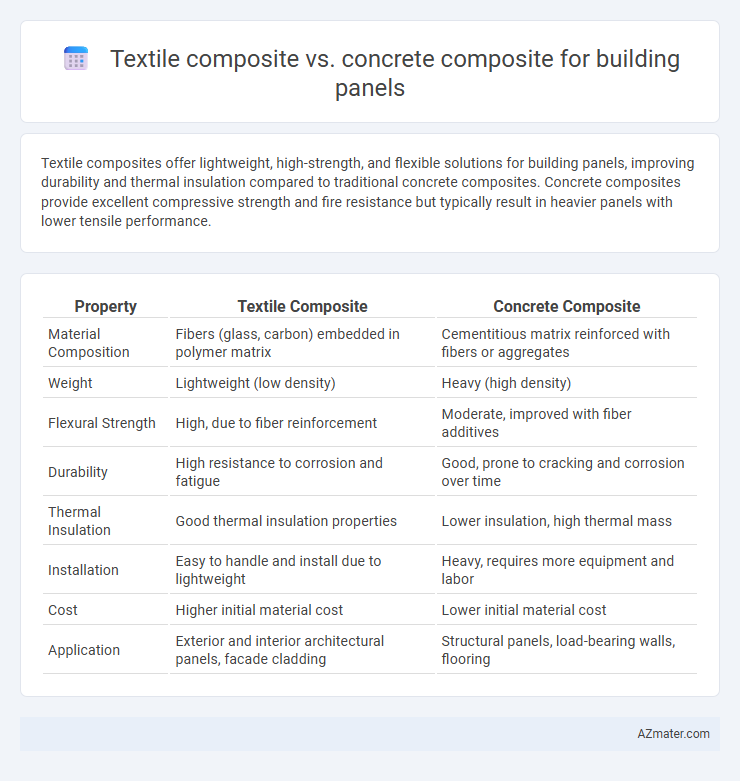Textile composites offer lightweight, high-strength, and flexible solutions for building panels, improving durability and thermal insulation compared to traditional concrete composites. Concrete composites provide excellent compressive strength and fire resistance but typically result in heavier panels with lower tensile performance.
Table of Comparison
| Property | Textile Composite | Concrete Composite |
|---|---|---|
| Material Composition | Fibers (glass, carbon) embedded in polymer matrix | Cementitious matrix reinforced with fibers or aggregates |
| Weight | Lightweight (low density) | Heavy (high density) |
| Flexural Strength | High, due to fiber reinforcement | Moderate, improved with fiber additives |
| Durability | High resistance to corrosion and fatigue | Good, prone to cracking and corrosion over time |
| Thermal Insulation | Good thermal insulation properties | Lower insulation, high thermal mass |
| Installation | Easy to handle and install due to lightweight | Heavy, requires more equipment and labor |
| Cost | Higher initial material cost | Lower initial material cost |
| Application | Exterior and interior architectural panels, facade cladding | Structural panels, load-bearing walls, flooring |
Introduction to Building Panel Composites
Building panel composites combine two or more materials to enhance structural performance, durability, and weight efficiency. Textile composites utilize fiber reinforcements like carbon or glass fabrics embedded in polymer matrices, providing high tensile strength and flexibility. Concrete composites integrate fibers or mesh within cementitious matrices, offering superior compressive strength and fire resistance for building panels.
Overview of Textile Composites
Textile composites for building panels consist of high-strength fibers such as carbon, glass, or aramid embedded in a polymer matrix, offering superior tensile strength and lightweight properties compared to traditional concrete composites. These materials enhance durability, corrosion resistance, and thermal insulation while reducing the overall structural weight, making them ideal for modern construction applications. Advanced textile composites also provide design flexibility and improved crack resistance, contributing to longer service life and reduced maintenance costs in building panels.
Overview of Concrete Composites
Concrete composites for building panels consist of a cementitious matrix reinforced with materials like steel fibers, glass fibers, or synthetic fibers, enhancing strength and durability. These composites offer superior compressive strength, fire resistance, and longevity compared to traditional materials, making them suitable for structural and facade applications. The integration of fibers improves crack resistance and reduces maintenance needs, contributing to sustainable building practices.
Mechanical Properties Comparison
Textile composites exhibit superior tensile strength and flexibility compared to concrete composites, making them ideal for applications requiring lightweight and high-performance building panels. Concrete composites provide excellent compressive strength and durability, suitable for structural load-bearing elements but are heavier and less adaptable to dynamic stresses. The mechanical properties of textile composites, including higher impact resistance and strain tolerance, contribute to enhanced seismic performance and reduced maintenance in building panels.
Durability and Weather Resistance
Textile composites exhibit superior durability and weather resistance compared to concrete composites, largely due to their high tensile strength and flexibility, which prevent cracking and structural damage under environmental stress. Their resistance to moisture, UV radiation, and chemical corrosion extends their lifespan in harsh weather conditions where concrete composites are prone to spalling, carbonation, and chloride ingress. These properties make textile composite building panels ideal for applications requiring long-term performance and minimal maintenance in variable climates.
Weight and Structural Efficiency
Textile composites used in building panels offer significantly lower weight compared to traditional concrete composites, enhancing ease of transport and installation. Despite their reduced mass, textile composites exhibit high tensile strength and flexibility, resulting in superior structural efficiency by optimizing load distribution and resistance to cracking. Concrete composites, while heavier and more rigid, provide excellent compressive strength but often require additional reinforcement to achieve comparable structural performance.
Sustainability and Environmental Impact
Textile composites in building panels offer significant sustainability advantages due to their lightweight nature, reduced material consumption, and potential for recycling, resulting in lower embodied energy compared to concrete composites. Concrete composites, while durable and strong, involve high carbon emissions during cement production and limited recyclability, contributing to a larger environmental footprint. The use of textile composites aligns with green building certifications by enhancing energy efficiency and minimizing waste, making them a preferable choice for environmentally conscious construction projects.
Cost Analysis and Economic Feasibility
Textile composites offer significant cost advantages over concrete composites in building panels due to lower material weight, reduced transportation expenses, and simplified installation processes. Manufacturing textile composite panels requires less energy and time, contributing to overall economic feasibility in large-scale construction projects. While initial material costs can be higher for textile composites, long-term savings from durability, maintenance reduction, and improved thermal insulation enhance their cost-effectiveness compared to concrete composites.
Application Suitability in Construction
Textile composites offer superior flexibility, lightweight properties, and high tensile strength, making them ideal for facade panels and lightweight cladding in building construction. Concrete composites provide exceptional compressive strength and durability, suitable for structural panels, load-bearing walls, and foundation elements in demanding environments. Selecting between textile and concrete composites depends on specific requirements like load capacity, weight constraints, and environmental exposure in construction projects.
Future Trends in Building Panel Materials
Textile composites offer superior flexibility, lightweight properties, and enhanced durability compared to concrete composites, making them increasingly attractive for future building panel applications. Innovations in nanomaterials and bio-based fibers are driving the development of sustainable textile composites that reduce carbon footprints and improve thermal insulation. Advanced manufacturing techniques like 3D weaving and automated fiber placement are expected to boost production efficiency and enable complex panel designs tailored for energy-efficient building envelopes.

Infographic: Textile composite vs Concrete composite for Building panel
 azmater.com
azmater.com